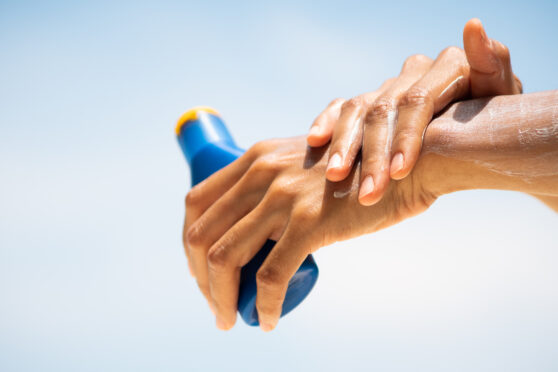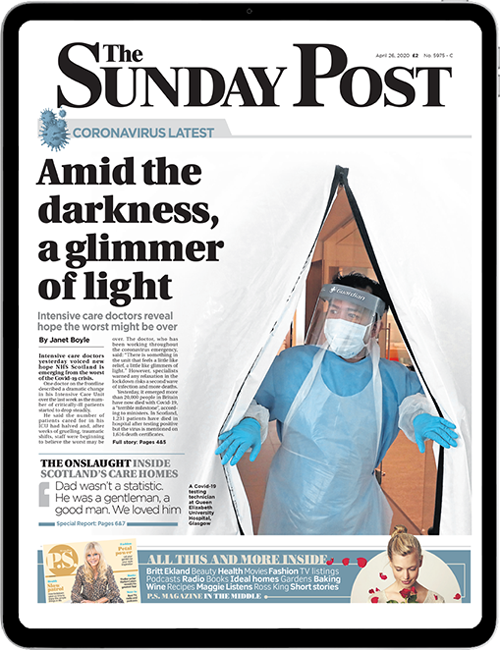
Sunscreen could be fuelling a superbug crisis lurking in our coastal waters, scientists claim.
Millions of Scots will soon be digging out the Factor 50 to ward off the risk of skin cancer on the beach and in the garden.
But new research suggests our obsession with blocking out the sun’s rays may be contributing to a health emergency looming on the horizon.
Superbugs – at one time harmless – kill around 700,000 people worldwide each year, but that figure is projected to reach 10 million by 2050 as they become immune to antibiotics.
Now Stirling University experts fear that sunscreen washed off in the shower or while swimming is feeding deadly bacteria.
Chemical impact
They have found the most commonly used UV-blocking chemical gives a boost to Pseudomonas, a strain of which is among the most contagious potential killers on our hospital wards, resistant even to penicillin.
And the research team – led by environmental microbiologist Dr Sabine Matallana-Surget – warns that sunscreen polluting our rivers and seas could end up costing lives.
Their study concludes: “We now begin to discover how ecologically significant and potentially harmful (microbes) are affected by this interaction. (There are) significant concerns for ecosystem stability and human health, particularly in coastal regions with high rates of tourism.”
Waste flushed into our rivers and seas from homes and hospitals is creating the perfect breeding ground for rogue bacteria.
Bugs flourish on plastic, and they can evolve quickly by swapping genes or mutating, learning to resist antibiotics in the polluted waters around them.
Now the latest study has shown that adding sunscreen into the mix can give some bacteria a boost. Sunscreen contains the chemical EHMC, which blocks UV light. But it clings to plastic and acts as fuel for Pseudomonas, the researchers found.
The team – a collaboration between Stirling and Mons University in Belgium – collected shoreline rubbish from Oban, Argyll, and took samples of the bacteria on it.
Half of the cultures were then exposed to the UV-filtering chemical EHMC.
Pseudomonas – and its cousin Psychromonas – flourished, and in the proteins being emitted there was evidence that the bug’s ability to resist antibiotics was being supercharged.
In a second finding of concern, EHMC also harmed types of bacteria that are good at breaking down plastic.
The study – published last week but yet to be peer reviewed – states: “Demand for products containing UV protection has grown exponentially. However, the frequent use of these, especially during swimming, directly exposes marine life to these pollutants while… municipal run-off further pollutes the ocean.”
It adds that EHMC enriched “potentially pathogenic genera like Pseudomonas while reducing the growth and activity of potential plastic degraders…further contributing to (plastic’s) persistence in marine environments. Targeted research and policy interventions are therefore urgently needed to mitigate these compounded ecological threats.”
Household and hospital drains send waste water to treatment plants, but these facilities find it difficult to remove chemicals such as EHMC and antibiotics. So the pollutants are still present when the cleaned water is pumped out into our rivers or the remaining sludge is spread on farmers’ fields as fertiliser.
Superbug battle
One in three Scots was prescribed antibiotics in 2023. The NHS wants to restrict their use to stem the tide of resistance – but is fighting a losing battle. Between 2018 and 2024, the number of superbug infections edged upwards, when the UK target was to cut them by 10%. In 2016, England’s then chief medical officer Dame Sally Davies warned that anti-microbial resistance was as severe a threat to the UK as terrorism.
Pseudomonas aeruginosa can cause pneumonia and sepsis and may prove fatal. An outbreak at Glasgow Royal Infirmary in 2020 killed one patient in the intensive care unit. And three babies died at a Belfast hospital in 2012 after the bug infested sink taps.
Hugh Pennington, emeritus professor of bacteriology at Aberdeen University, said: “Sunscreen and antibiotics should be used only when required. They can be lifesaving, but – as this research demonstrates – if overused, they will create problems further down the line, probably for somebody else. People need to be educated about this.
“Sunscreen should not be used as a matter of course or for cosmetic reasons. It’s very difficult to remove it from waste water and we know there hasn’t been enough investment in sewage treatment.
“Pseudomonas is pretty common and is resistant to start with, so we should avoid actions that make it more difficult to treat. If you have weakened immune defences or wounds, it can really be quite a dangerous bug.”

Enjoy the convenience of having The Sunday Post delivered as a digital ePaper straight to your smartphone, tablet or computer.
Subscribe for only £5.49 a month and enjoy all the benefits of the printed paper as a digital replica.
Subscribe © Supplied
© Supplied